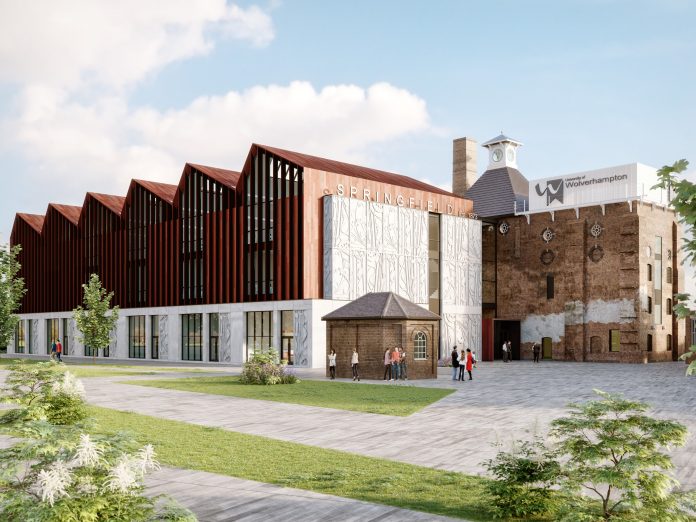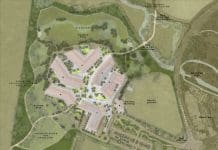The Brownfield Research & Innovation Centre will bring together specialist research, detail data and academic expertise to support the redevelopment of previously used land with capacity for thousands of much-needed new homes. Professor Mohammed Arif of the University of Wolverhampton discusses its development
The Brownfield Research & Innovation Centre (BRIC) is a research centre currently based at the University of Wolverhampton’s City Campus in the centre of Wolverhampton. It is a project part-funded by the European Regional Development Fund (ERDF) to help the Black Country region and SMEs with brownfield redevelopment challenges.
The Black Country region is comprised of four councils: Dudley, Sandwell, Walsall and Wolverhampton. They have identified the need to explore the barriers associated with brownfield land development, due in large part to the area’s industrial heritage and mining legacy.
Brownfield sites are defined as any previously developed land that is not currently in use, whether contaminated or not, such as derelict factory sites and industrial sites.
Rapid growth in regions surrounding large metropolitan areas leads to the phenomenon of urban sprawl. In England, there is sufficient brownfield land available and suitable for residential development, based on 2009 figures, for 1,494,070 new dwellings. This is equivalent to approximately 10 years’ supply at 2009 rates.
Of the national total, there is sufficient land available for 740,920 new residences in the southern regions (London, the South East and the South West). Local authorities now see these abandoned or unused areas as essential assets in realising the goal of urban revitalisation.
The Midlands Engine
One of the long-term strategic plans of the government is for the region to become ‘The Midlands Engine,’ creating growth and employment within the UK economy.
There are over 550 housing sites available within the area to deliver 45,000 new homes, according to 2016 figures from the Black Country LEP.
The development of strategic locations both for employment and housing land is one of the key priorities identified in the West Midlands Combined Authority Strategic Economic Plan and City Deal.
BRIC’s goal is to become the Brownfield Centre of Excellence in the UK and contribute to long-term plans for urban regeneration, especially in the West Midlands.
The BRIC project has been created to form the essential and much-needed core of brownfield expertise in the Black Country. In addition to mapping and plotting the many brownfield sites across the region, the centre will develop a knowledge bank on remediation best practice and will share gathered intelligence and expertise with stakeholders in both the public and private sectors. It will identify, research and support regional demand for the release of brownfield land for development in the Black Country.
The BRIC project is investing in the latest industry standard equipment in analysis, scanning and land and ground surveying. These facilities will be utilised by companies in collaboration with the centre for site analysis and research.
Proposed functions:
Innovative solutions: Research and develop cost-effective, sustainable, long-term innovative solutions for brownfield development.
Data centre: A centralised database of geotechnical, geochemical, geophysical, economic and ecological data associated with site development to allow more robust Phase 1 and Phase 2 site investigations to be delivered, reducing developer uncertainty and providing more accurate remediation costings.
Assistance: Provide bespoke support for Black Country SMEs with brownfield remediation challenges.
Remediation guidance: To offer advice and guidance on site remediation based on previous experience and real-life case studies.
Bio-remediation and environmental sensitivities: Develop environmentally sound and innovative solutions for complex remediation issues.
Building restoration: Offer free advice and guidance from industry and academic professionals on how buildings can be restored, remediated and brought back into use.
Resources: Pooling the limited specialist brownfield resources within this field to provide greater impact across the region.
Collaborative guidance: Informal lobbying function to government bodies to limit the over-specification of sites.
The dedicated BRIC team comprises of a brownfield professor, project director, project manager, knowledge transfer manager and three dedicated researchers.
Using the specialist skills and knowledge of the University of Wolverhampton’s academic and research staff from within the Faculty of Science & Engineering, BRIC’s services include:
Soil scanning: BRIC makes the best use of its state-of-the-art XRF, XRD and Electron Microscope equipment and can provide an accurate assessment of contaminants present in the soil.
Building scanning: Ability to map spaces both within and outside of existing building structures, helping you to plan renovation works and retrofitting (as in Fig. 1).
Geographic Information Systems (GIS): Using GIS to identify site suitability and to provide specific spatial or geographic data.
Soil analysis and remediation techniques: BRIC’s academic professionals collect and analyse your material samples, providing robust information and innovative remediation techniques.
Water table or surface water contamination and odour control: Collate exploratory data and research the best way to address these issues.
The Springfield Project
Urban regeneration is a central focus of the £100m Springfield Project, turning a 12-acre, Grade II listed former brewery into a centre of excellence for architecture and the built environment. BRIC is an integral component of the Springfield Project, which will also be the new home of the university’s School of Architecture & the Built Environment.
The brewery was built in 1873, finally closing in 1991. The site then lay abandoned for many years and in 2004, a ferocious blaze ravaged much of the site. In true ‘Phoenix’ fashion, the new University of Wolverhampton super-campus is emerging from this derelict brownfield site. Indeed, Springfield itself will be a case study for the regeneration of brownfield land.
The BRIC project was established in 2017 to support companies involved in brownfield land remediation and regeneration in the Black Country. Additionally, it will build an archive of research and information that can be accessed by companies, developers and contractors.
The focus of BRIC project is on the Black Country but progressively our partnerships will widen to embrace regional, national and international arenas.
BRIC aims to develop and integrate with the proposed National Brownfield Institute and will function as the Silicon Valley of brownfield expertise. Its information-rich and updated repository, along with its detailed, GIS-based brownfield sites database, will not only assist key developers and remediation contractors but will also support and attract end users.
Professor Mohammed Arif
Head of the School of Architecture & Built Environment
University of Wolverhampton
Tel: +44 (0)1902 32 2261
Twitter: @wlv_uni

















